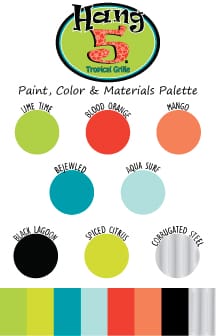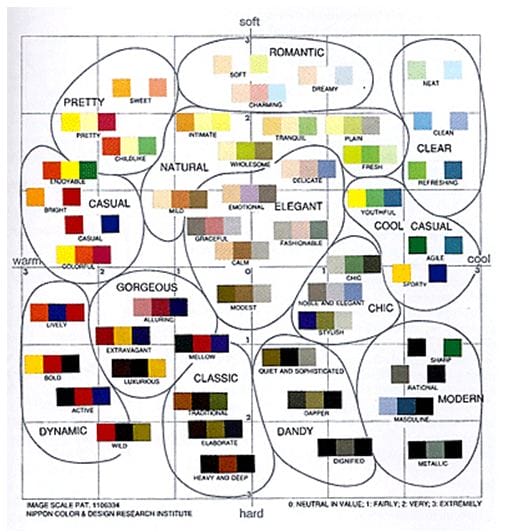Red is exciting, orange is energetic, yellow is happy, green is peaceful, blue is calming, purple is mysterious – so there ya have it. We have colors with a side of words. One order of color psychology fast and easy. Just like lunch from a drive-thru.
Many online resources (color drive-thrus if you will) handily provide lists of words to go with colors and colors to go with words. And there are just as many color scheming sites you can use to fill in squares and rectangles with color to build your own creative palettes.
All fun, all great. But. . .
What are you supposed to *DO* with it; the words, the colors. Where are they suppose to go and what do they do when they get there – alone or in combinations?
Information about color psychology isn’t hard to come by, it’s what to do with it and how to effectively apply it that’s challenging.
When you’re a designer there comes a point where what you do becomes reflex. Choosing the right colors for the brand Hang 5 just happened. I knew what I wanted. Didn’t think twice.

So, how did I get to the point where the right words and associations to go with those particular colors fell effortlessly out of my head? I’d say it’s a mix of common sense, natural color instinct, and a lot of experience working with color across many disciplines.
If you aren’t super experienced with color or confident in your ability to apply color psychology, there’s a fabulous resource you should know about: Colour Image Scale by Shigenobu Kobayashi (1992-03-01). He is regarded as Japan’s leading color psychologist.
SHIGENOBU KOBAYASHI graduated from Hiroshima College of Technology and received his master’s degree from Waseda University for his work in the field of color psychology. In 1966, he founded the Nippon Color & Design Research Institute (NCD) and has since become a leader in the field of color psychology. Kobayashi is the author of over 30 books on color in the Japanese language, with total sales in excess of 400,000 copies. Kobayashi is also an active participant of the International Color Association (AIC) and a lecturer at the graduate school of the Musashi Institute of Technology.
The author is Japanese and one might think – due to cultural differences – there would be conflicts when it comes to interpreting color meanings and symbolism for use in the U.S. I’d have to say there are no major conflicts. In fact, this book illustrates just how universally the language of color can apply.

The book is bursting with colors, easy-to-read charts, and useful diagrams.
RGB values or HEX codes, etc. are not included. The colors printed are for general reference only but they are more than sufficient quality to make this book a great color tool.

Copies available as of today are pricey. This is not a casual-use type reference book. However, it’s worth every penny if you decide it’s a good fit for you.
This is one of my favorite reference books!
Hi, Sara. It is one of my favorites too. It has gotten me “unstuck” more times than I can count! I can’t believe it’s $77 now! The price info is still in tact on the back jacket of my book. You guys ready for this? I bought it on February 25, 1997 for $18.00. And I thought THAT was a lot for a little (but mighty) book back then.
LS –
Your intuition is unparalleled. The objective for ‘all color designers’ should be complete understanding of how to use our references and instinctual skill to deliver the customer’s package in surprising ways he never dreamed, but could ‘see’ in his head.
I checked out the Amazon reviews “This book provides an elaborate color theory that makes the color wheel look like stupid hippy frisbee.” and so I’ve just purchased a copy.(£50) Pricey, but worth it. (And tax deductible). Great post – highly informative, thank you, Lori.
My personal favs are:
Josef Albers – Interaction of Color (Josef & Anni Albers are my heroes!)
Itten – The Elements of Color
Garth Lewis – 2000 Colour Combinations (GL was my tutor at college)
Rolf G. Kuehni – Color, Essence & Logic.
Sounds good Lori, are there any other books on color psychology that you recommend? Sometimes it sounds to me like you sort of make fun of the idea, like it’s too simplistic, so I’m confused. Do you buy into it or not? Do you know of any books that talk in-depth about how we interact with color in our surroundings?
I ordered this one from Interlibrary Loan to check it out before I spend that much $.
I am absolutely 100% on board with applied color psychology. I am absolutely poking at efforts to over simplify it – not necessarily poking “fun” – but my intentions are definitely to inspire people to really think about color, peel into it, ask more questions, seek a broader understanding.
I mean, I think there is more to yellow than just “happy” don’t you? Remember the movie “Super Size Me” about the guy who ate McDonald’s 3 times a day for 30 days. No one in their right mind would do that, McDonald’s never intended for anyone to make the most unhealthy choices possible from their menu 3 times a days for 30 days. But Morgan Spurlock did it to prove a point. The result was after 30 days he was measurably less healthy.
Mr Spurlock turned to a drive-thru when he was hungry and was on a steady diet of fast food that filled his gut but didn’t nourish his body. Similarly, the color community has been turning to the internet to quell a hunger for color knowledge. We’ve been on a steady diet of fast color sound bites that filled our heads with unsubstantial information but doesn’t give us anything of quality to grow on.
The difference between Mr. Spurlock and many of the more inexperienced in the color community is that Mr. Spurlock knew better, he knew what he was doing. The novice among us in color world do not know any better.
Anyone can position themselves as a color expert. Anyone can put tomes of search-engine-friendly color information on their website or blog. But that doesn’t mean that color information is good for us – or that it was meant to be our sole resource – or that it was meant for constant consumption. Unless someone points out that a big chunk of what’s out there is not necessarily the best quality, then many might not ever realize just how BIG color world really is. How smart it can be. How intense. How intellectually stimulating and challenging. How exciting it can be.
I don’t think I can point to any one book. Rather a mix. Heather shared a nice list up there. I would include Birren, Mahnke and tip-toeing into the metaphysical realms of color. For example, “Color Healing Home” by Beazley and Cumming.
Hello all,
As a colour lover, I fell in love with this book that a friend recently showed me. It is the life works of a Japanese Kimono artist, Itchiku Kubota.
Absolutely stunning! If colour is your thing, you will probably spend hours marveling at these intricate landscapes. Heather suggested I add it to this list, so here it is:
http://www.amazon.co.uk/dp/0500976856/ref=pe_41821_22887771_pe_abandon_t1
Cheers,
Ingrid